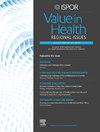Assessing Women’s Preference and Willingness to Pay for Breast Cancer Screening: A Discrete Choice Experiment Approach
IF 1.4
Q3 HEALTH CARE SCIENCES & SERVICES
引用次数: 0
Abstract
Objectives
This study aimed to explore women’s preferences regarding breast cancer screening using a discrete choice experiment and willingness-to-pay analysis.
Methods
A discrete-choice experiment was conducted among 255 women aged 40 to 65 years who were referred to health centers in Tehran city. The experiment included attributes such as screening methods (clinical examination and mammography), number of deaths prevented, possibility of misdiagnosis and unnecessary biopsy, screening intervals, and cost of the screening test. A conditional logit model was used to estimate preferences, and willingness-to-pay values were derived from the model coefficients.
Results
Women revealed a strong preference for mammography over clinical examination(odds ratio [OR] 1.73; 95% CI 1.47-2.04; P < .001). Compared with 1 death prevented per 1000 women, the ORs for 3 and 6 deaths prevented per 1000 women were 18.1 (95% CI 12.72-25.75; P < .001) and 74.48 (95% CI 49.41-112.27; P < .001), respectively. The ORs for misdiagnosis and unnecessary biopsy rates of 10 of 100 people were 0.006 (95% CI 0.003-0.012; P < .001). Preferences for screening intervals varied, with a higher preference for screening every 4 years (OR 2.77; 95% CI 1.73-4.43; P < .001) compared with annual screening. The cost was also a significant factor, with a decrease in the odds of choosing a screening option as the cost increased (OR 0.139; 95% CI 0.1396-0.1399; P = .001).
Conclusions
This study provides valuable insights into women’s preferences for breast cancer screening in Iran.
评估女性对乳腺癌筛查的偏好和支付意愿:离散选择实验方法
目的本研究旨在通过离散选择实验和支付意愿分析来探讨女性对乳腺癌筛查的偏好。方法对255名40 ~ 65岁的妇女进行离散选择实验。实验包括筛查方法(临床检查和乳房x光检查)、预防死亡人数、误诊和不必要活检的可能性、筛查间隔和筛查试验的成本等属性。使用条件logit模型估计偏好,并根据模型系数推导出支付意愿值。结果女性对乳房x光检查的偏好高于临床检查(优势比[OR] 1.73;95% ci 1.47-2.04;P & lt;措施)。与每1000名妇女预防1例死亡相比,每1000名妇女预防3例和6例死亡的or为18.1 (95% CI 12.72-25.75;P & lt;.001)和74.48 (95% CI 49.41-112.27;P & lt;措施),分别。100人中有10人的误诊和不必要的活检率的or为0.006 (95% CI 0.003-0.012;P & lt;措施)。对筛查间隔的偏好各不相同,更倾向于每4年筛查一次(OR 2.77;95% ci 1.73-4.43;P & lt;.001)。成本也是一个重要因素,随着成本的增加,选择筛查方案的几率降低(OR 0.139;95% ci 0.1396-0.1399;P = .001)。结论:本研究为了解伊朗女性对乳腺癌筛查的偏好提供了有价值的见解。
本文章由计算机程序翻译,如有差异,请以英文原文为准。
求助全文
约1分钟内获得全文
求助全文
来源期刊

Value in health regional issues
Pharmacology, Toxicology and Pharmaceutics-Pharmacology, Toxicology and Pharmaceutics (miscellaneous)
CiteScore
2.60
自引率
5.00%
发文量
127
 求助内容:
求助内容: 应助结果提醒方式:
应助结果提醒方式:


